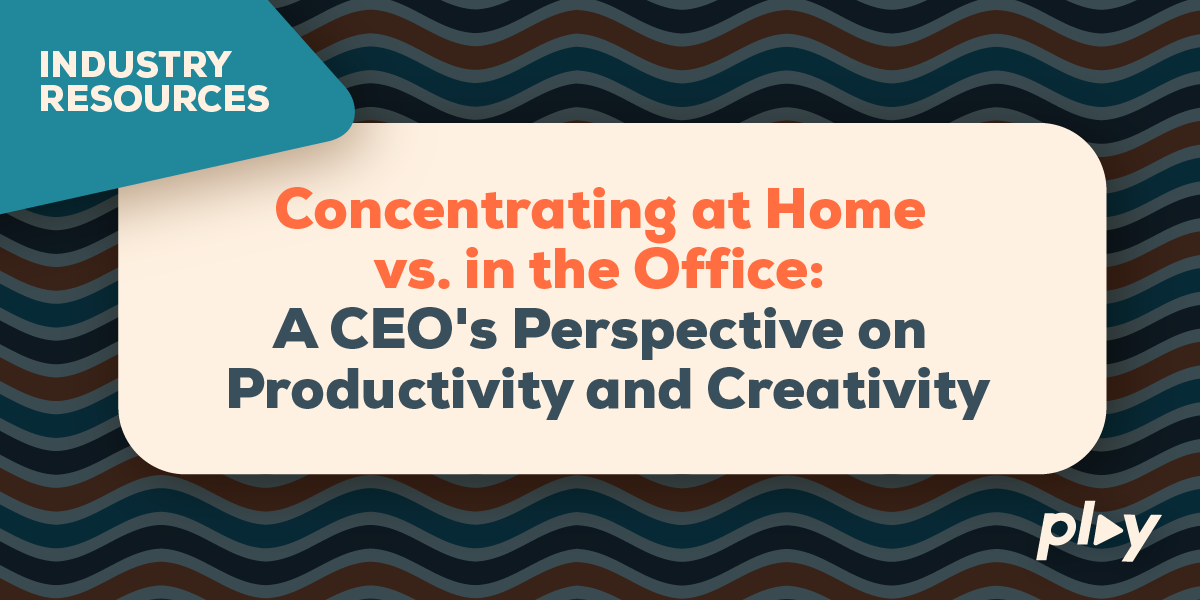Concentrating at Home vs. in the Office: A CEO’s Perspective on Productivity and Creativity

The debate over where employees are most productive—at home or in the office—has taken center stage. As the CEO of PLAY Creative, I’ve observed the shifts in work dynamics and have analyzed how they affect our productivity, creativity, and ultimately, our marketing strategies. Let’s dive into the data, research, and analytics to explore this complex topic.
The Productivity Puzzle
Productivity is the cornerstone of any successful business. A study by Stanford University found that remote workers are 13% more productive than their in-office counterparts. This productivity boost is attributed to fewer distractions, less time commuting, and more flexible work hours. However, another survey by Microsoft revealed that 54% of employees feel overworked, and 39% feel exhausted due to remote work. This contradiction points to the nuanced nature of productivity.
In our agency, we’ve noticed that tasks requiring deep focus, like data analysis and strategic planning, often benefit from the quiet home environment. On the other hand, creative brainstorming sessions thrive on the spontaneous interactions and energy of the office.
Key Takeaway: Balancing remote and in-office work can optimize productivity by aligning task types with the most conducive environments.
Creativity and Collaboration
Creativity is the lifeblood of marketing. The Journal of Business Research highlights that physical proximity fosters creativity through spontaneous interactions and unplanned collaborations. At PLAY Creative, our best ideas often emerge from casual hallway conversations or impromptu office whiteboard sessions.
However, the remote work model has its own creative advantages. Digital collaboration tools like Miro and Slack have redefined brainstorming sessions, making them more inclusive and allowing for asynchronous idea sharing. A study by Harvard Business Review found that hybrid teams generate more innovative ideas than fully remote or fully in-office teams, as they combine the best of both worlds.
Key Takeaway: A hybrid model enhances creativity by leveraging the spontaneous collaboration of office work and the inclusive, flexible nature of remote work.
Employee Well-being and Engagement
Employee well-being is directly linked to productivity and creativity. According to Gallup, employees who work remotely at least part-time are more engaged and report higher well-being. Yet, the same report notes that complete isolation can lead to feelings of loneliness and disengagement.
At PLAY Creative, we’ve implemented regular virtual check-ins and team-building activities to maintain a sense of community. Additionally, our flexible work policy allows employees to choose their work environment based on personal preference and job requirements, leading to higher satisfaction and retention rates.
Key Takeaway: A flexible work policy that prioritizes employee well-being can enhance engagement, productivity, and creativity.
Data-Driven Decisions
As a data-driven agency, we rely heavily on analytics to guide our strategies. We use tools like Time Doctor to monitor productivity patterns and identify trends. Our internal surveys help us understand employee preferences and pain points. This data informs our hybrid work model, ensuring it evolves with our team’s needs and industry trends.
Key Takeaway: Continuous data analysis is crucial in refining work models to maximize productivity, creativity, and employee satisfaction.
Conclusion
The debate between concentrating at home versus in the office is not about choosing sides but finding a harmonious balance. As we navigate this new era of work, it’s essential to remain flexible, data-driven, and employee-centric. At PLAY Creative, we believe that by embracing the hybrid model, we can harness the strengths of both environments, fostering a culture of productivity, creativity, and well-being.
The future of work is not a one-size-fits-all solution. It’s a dynamic, evolving landscape that requires us to be agile, innovative, and empathetic. As we continue to adapt, we are committed to leveraging data and insights to create a work environment that empowers our team to thrive, whether they are at home, in the office, or somewhere in between.
